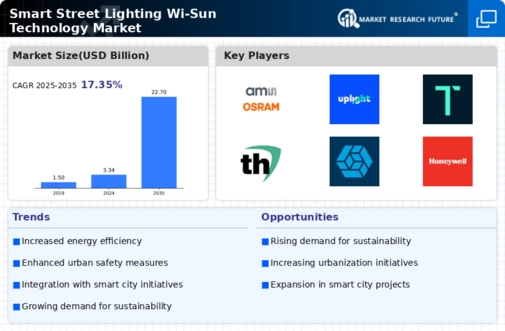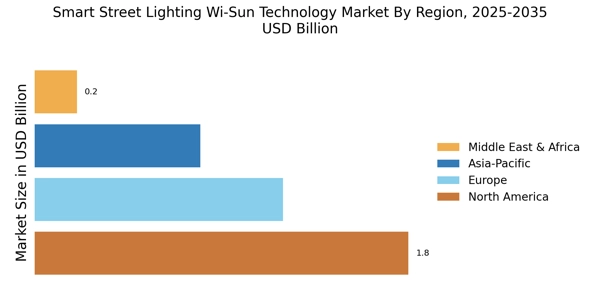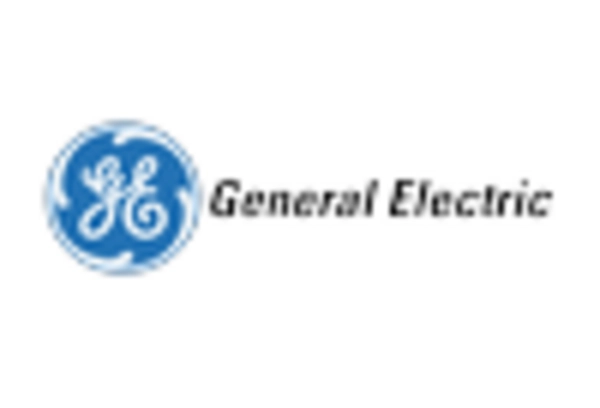Focus on Energy Efficiency
Energy efficiency remains a pivotal driver in the Smart Street Lighting Wi-Sun Technology Market. With rising energy costs and increasing environmental concerns, municipalities are prioritizing solutions that minimize energy consumption. Smart street lighting systems equipped with Wi-Sun technology enable adaptive lighting, which adjusts brightness based on real-time conditions, thereby optimizing energy use. Reports indicate that cities adopting these systems can achieve energy savings of approximately 30-50%. This focus on energy efficiency not only lowers operational expenses but also aligns with global sustainability targets, making the Smart Street Lighting Wi-Sun Technology Market an attractive investment for forward-thinking municipalities.
Government Incentives and Regulations
Government incentives and regulations play a crucial role in shaping the Smart Street Lighting Wi-Sun Technology Market. Many governments are implementing policies that encourage the adoption of energy-efficient technologies, including smart street lighting systems. These initiatives often come in the form of grants, tax incentives, or regulatory frameworks that promote sustainable urban development. For instance, certain regions have established mandates requiring municipalities to transition to energy-efficient lighting solutions by specific deadlines. Such regulatory support not only accelerates the adoption of smart street lighting but also enhances the overall market landscape, making the Smart Street Lighting Wi-Sun Technology Market more appealing to investors and stakeholders.
Advancements in Connectivity Solutions
The Smart Street Lighting Wi-Sun Technology Market is propelled by advancements in connectivity solutions. Wi-Sun technology, known for its robust and reliable communication capabilities, facilitates seamless integration of street lighting with other smart devices. This connectivity allows for real-time monitoring and control, enhancing operational efficiency. As cities increasingly adopt Internet of Things (IoT) frameworks, the demand for reliable connectivity solutions in street lighting is expected to rise. Data suggests that the market for smart street lighting is projected to grow at a compound annual growth rate of over 20% in the coming years, driven by these technological advancements. The Smart Street Lighting Wi-Sun Technology Market stands to benefit significantly from this trend.
Integration with Smart City Initiatives
The Smart Street Lighting Wi-Sun Technology Market is increasingly influenced by the integration of smart city initiatives. As urban areas evolve, municipalities are adopting smart technologies to enhance infrastructure and improve public services. This integration often includes smart street lighting systems that utilize Wi-Sun technology for efficient communication and control. According to recent data, cities implementing smart street lighting have reported energy savings of up to 50%, which not only reduces operational costs but also contributes to sustainability goals. The synergy between smart street lighting and other smart city components, such as traffic management and environmental monitoring, further amplifies the value proposition of the Smart Street Lighting Wi-Sun Technology Market.
Growing Urbanization and Population Density
The trend of growing urbanization and increasing population density is a significant driver for the Smart Street Lighting Wi-Sun Technology Market. As more people migrate to urban areas, the demand for efficient and effective public services, including street lighting, intensifies. Smart street lighting systems equipped with Wi-Sun technology can address these challenges by providing enhanced visibility and safety in densely populated areas. Furthermore, urban centers are often under pressure to reduce their carbon footprint, and smart lighting solutions contribute to this goal by optimizing energy use. The Smart Street Lighting Wi-Sun Technology Market is likely to see substantial growth as cities adapt to these demographic shifts and seek innovative solutions to manage urban infrastructure.


















Leave a Comment